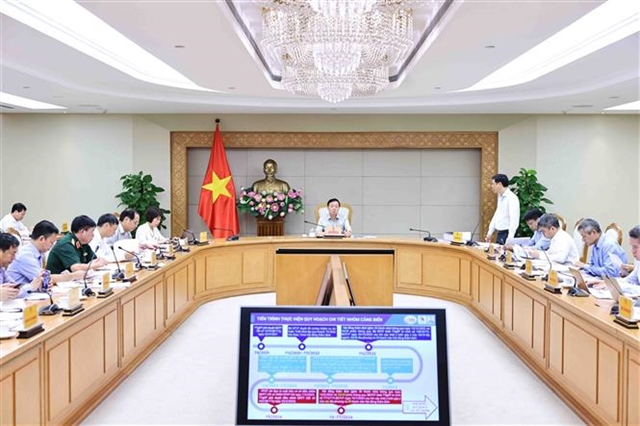 Society
Society

 |
| At the meeting. VNA/VNS Photo |
HÀ NỘI — Deputy Prime Minister Trần Hồng Hà has called for port planning and development to prioritise mechanisms and policies that guarantee the safe and efficient growth of seaport infrastructure, aiming to attract investment from leading global shipping lines.
He emphasised the need for a "dynamic and open" approach to ensure timely adaptation to technological advancements and international changes.
He made the request while chairing a meeting yesterday with various ministries, sectors and localities to discuss the draft of the Detailed Master Plan for Seaport Groups.
The plan, which covers ports, terminals, wharves and floating docks, sets out details for the period 2021-2030, with a vision extending to 2050.
During the meeting, Deputy Minister of Transport Nguyễn Xuân Sang highlighted the significance of the plan as a crucial step in refining the broader master plan for the seaport system.
He emphasised that this planning is vital for developing policies and strategies that align with socio-economic growth, while safeguarding the security of local, regional and national interests.
The plan includes specific projections for each seaport and port area, detailing the number of berths, docks and port types needed by 2030. It also estimates the scale of major port areas for the 2030-2050 period to attract comprehensive investment.
Key areas of focus include Nam Đồ Sơn, Con Ong-Hòn Nét, Liên Chiểu, Cần Giờ, Cái Mép Hạ, the Cái Mép Hạ lower-area and Trần Đề.
The plan further proposes the development of public maritime infrastructure, guidelines for connecting transport infrastructure and orientations for the expansion of other docks and berths, laying a foundation for future planning efforts.
Targets are set for cargo and passenger volumes, along with infrastructure needs, for each port group, aligning with forecasted growth.
By 2030, total cargo volume is projected to exceed at least 1,249 million tonnes (under a low scenario) and 1,493 million tonnes (under a high scenario) with container cargo numbers ranging from 46.3 to 54.3 million TEUs. Passenger numbers are expected to reach between 17.382 and 18.845 million trips.
The plan also updates Hồ Chí Minh City's seaport, referenced as a special potential port, incorporating the Cần Giờ International Transhipment Port (in accordance with Decision No 442/QD-TTg). This update aims to optimise investment efficiency in seaport infrastructure and ensure a systematic, coordinated connection among seaports, sectors and regions nationwide, while safeguarding social security and national defence.
Throughout the discussions, representatives from ministries, sectors, localities, and corporations provided feedback on the plan.
Their insights are expected to significantly enhance services related to container port operations, including container handling, customs, freight transport and the use of docks, berths and buoy stations.
Environment must be prioritised
Later the same day, Deputy Prime Minister Trần Hồng Hà reviewed the investment policy for the Saigon Gateway International Transhipment Port Project.
The Deputy PM directed the Ministry of Planning and Investment to coordinate with the Ministry of Agriculture and Rural Development, the Ministry of Natural Resources and Environment, the Ministry of Transport, HCM City People's Committee and other relevant ministries and sectors, to ensure the project’s alignment with related plans. He urged the swift completion of the dossier for investment policy approval.
Deputy PM Hà emphasised that the environment must not be compromised, advocating for overall and harmonious benefits while avoiding conflicts with other projects. He stressed that the project must contribute to the goal of developing internationally and regionally competitive seaports, attracting investors with strong technological, human resource and management capabilities.
According to the Ministry of Planning and Investment, the Saigon Gateway Project in Cần Giờ District is currently under consideration for investment policy approval. The project involves services related to container port operations, with a projected land use of 571ha and a total investment of approximately VNĐ113.5 trillion (over US$4 billion) to be implemented over seven phases, spanning 22 years.
A representative of the HCM City People's Committee reassured that an environmental impact assessment would be thoroughly conducted during the feasibility study, in accordance with environmental laws, to ensure that the project does not impact the Cần Giờ Mangrove Biosphere Reserve.
The project will adhere to modern, environmentally friendly port operation technologies to protect the ecological environment, particularly the Cần Giờ Mangrove Biosphere Reserve.
Representatives from the Ministry of Foreign Affairs and the Ministry of Natural Resources and Environment highlighted the project's location within the buffer zone of the biosphere reserve, which includes a UNESCO-recognised regenerating mangrove forest. They stressed the necessity of rigorous environmental impact assessments and further evaluation of land use planning around the project area to ensure its alignment with the overall master plan.
Deputy Minister of Science and Technology Hoàng Minh pointed out the lengthy project timeline and suggested that the project report clarify development trends and technology transfer to avoid poorly forecasted technology developments that could lead to inadequate investments and early obsolescence. VNS




